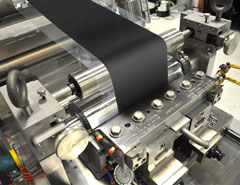Coating Matters | Free Span Coating
- Published: July 17, 2012, By Mark Miller
 In the world of precision slot die coating, precision rolls are an important variable in the process equation. The fluid and substrate are sandwiched in between two pieces of metal (the slot die and the roll), and the precision grinding capability of these manufacturers are put to the test. But what if we can remove some of the inherent variability in the process? One would think the coating would be more uniform.
In the world of precision slot die coating, precision rolls are an important variable in the process equation. The fluid and substrate are sandwiched in between two pieces of metal (the slot die and the roll), and the precision grinding capability of these manufacturers are put to the test. But what if we can remove some of the inherent variability in the process? One would think the coating would be more uniform.
That is where free span coating comes in! If the slot die is positioned between two idler rolls, then the only surface the fluid from the die connects with is the substrate. This reduces the variation in the roll as a player in the coating process. Free span coating also is referred to as tensioned-web-over-slot-die (TWOSD), and this accurately describes the process. Instead of creating a fluid bead by controlling the distance of the slot die to the roll and accommodating the substrate, in free span coating the tensioned web applies pressure back on the slot die. The distance is controlled by the fluid instead of mechanically, which proves out some interesting coating techniques.
In practice what does free span coating allow you to do with your process that proximity roll coating does not? For one it allows for thinner liquid layers to be coated. Free span coating also allows for conformability to the substrate versus conformability to the precision roll. But with every new technique comes new opportunities. The coating defects associated with free span coating require a different set of process understanding tools to attack air entrainment and liquid-substrate interfaces. And remember, the substrate now has an extreme curve in it…in exactly the opposite direction it did around a roll!
So if you take into account the reverse bend in the substrate, the fluid barrier, and the new reaction to process set points, there is a lot to learn if you are used to running a slot die against a chrome roll. But keep in mind the possibilities associated with the flexibility of the new coating method. As an example, the new world of battery coating requires fluid to be placed on both sides of a foil if the product is going to be produced efficiently. Because the final structure of the battery allows for a single foil to have slurry coated and cured on both sides of the substrate, it is advantageous to simultaneously coat the cathode on both sides of the aluminum foil or the anode on both sides of the copper foil. The trick is to determine how to process two wet coatings on one substrate without damaging the slurry prior to curing the system.
With different physical arrangements, different process considerations are presented. The slot die process engineer needs to think about whether a direct coating method, with a precision roll, is ideal or whether a free span coating method, without a roll, will provide the most process capability.
Whether you want an improved process control or an improved fluid placement on a web, free span coating provides a developing coating arrangement that may help you in a new product development. Happy coating, whatever position you choose!
Roll-to-roll coating industry expert Mark Miller, owner of Coating Tech Service, has 14+ years of slot die coating experience and troubleshooting. Contact him at 715-456-9545; mark@coatingtechservice.com; www.coatingtechservice.com.
[Image courtesy Premier Dies Corp., 2700 Olson Dr., Chippewa Falls, WI 54729; 715-723-0513 X12; contact Bob Shakal, VP, rshakal@premierdies.com]













